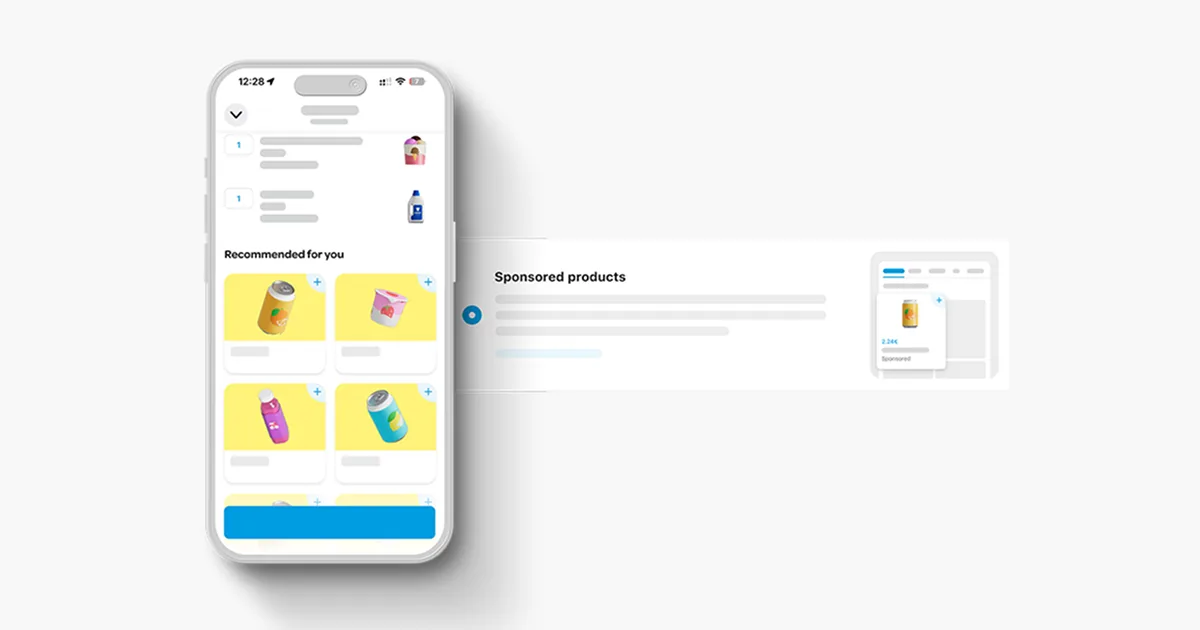Showing up at the right time: why timing matters in retail media advertising
Show up exactly when it counts: learn how retail media advertising reaches ready-to-buy shoppers at the perfect moment for real impact.

Have you ever noticed how certain ads pop up precisely when you’re already thinking about making a purchase?
You’re scrolling a supermarket app for healthy snacks, and there it is: a sponsored listing for exactly the gluten-free chips you've been craving.
It's as if the ad knows your intentions.
But that's no coincidence, it's retail media advertising at work.
In simple terms, retail media advertising means placing your ads right inside shopping environments—like retailer websites, apps, or digital store displays—where people are actively searching or ready to buy.
This method taps into a powerful psychological concept known as recency theory and the Decision Lab explains it best:
“The recency effect plays a pivotal role in shaping consumer preferences and evaluations, with users often giving more weight to their most recent experiences with a product. The recency effect is also leveraged by businesses and brands to enhance sales and marketing efforts by subtly influencing customer behaviour.”
This is the power of timing in retail media advertising. It’s about meeting high-intent shoppers exactly when they’re actively considering or searching for a product.
The psychology of shopping: Why timing matters
It might seem obvious that “the right ad at the right time” works. But beneath that cliché is a deeper psychological truth: decision fatigue.
According to The Brain Trust, when shoppers are overloaded with choices, they naturally latch onto the first relevant solution they see. If your ad lands precisely then, you’re not just another option—you’re providing relief and helping shoppers feel confident about their choice.
“Buyers experiencing decision fatigue are likely to simplify their decision criteria, focusing on one or two easily comparable factors rather than evaluating the full range of benefits and drawbacks. This can lead to suboptimal choices.” (The Brain Trust)
And that’s crucial for anyone who manages brand positioning and budgets. You want more than random clicks; you want people who are primed to buy.
Quick Thought: If you’re a brand manager championing a new line of eco-friendly cosmetics, would you rather be on a billboard that drivers pass at 60 mph, or in front of app users already hunting for “organic skincare”?
Retail media: Meeting demand instead of manufacturing it
Traditional ads often try to manufacture demand, throwing messages at broad audiences in the hopes someone might care.
Retail media taps into existing buyer intent. It’s the difference between a department store loudly promoting “Clothes for Everyone!” and a specialized boutique that helps you find the perfect fit.
Sponsored Products, Banner Ads, and tailored search placements can guide shoppers to your brand at the exact time they’re open to discovering something new. These ads are tied to what people are actively searching for, like “lactose-free cheese” or “luxury candles.” When your brand appears in that moment, you become part of the solution.

Marc Brodherson of McKinsey sums up what this means for companies:
“By 2028, we believe that spending in retail and commerce media will be bigger than for all of global television and streaming advertising. This provides an unprecedented opportunity to do closed-loop advertising where a company can say ‘I know an ad appeared and I know it did or did not lead to a purchase.”
By zeroing in on high-intent shoppers, you’re far more likely to see that casual glance turn into a cart full of products. This quality-over-quantity approach means you’re focusing your efforts on people who are already leaning in.
As an example, let’s say you sell premium cold brew coffee. A self-serve platform such as Wolt Ads for Brands can present your product right when someone searches for “iced coffee.” That immediate proximity to purchase intention is exactly what most brand managers crave.
Why brands need full control over their ads
As shopping becomes more digital, there’s a need for brands to take charge of their campaigns. Real-time reporting and on-the-spot adjustments let you respond instantly to market shifts.
Maybe one product is starting to trend because of a new social media challenge. You might want to ramp up its ad budget for a quick burst of sales before the trend cools down.
That’s why self-service platforms (like Wolt Ads for Brands, Amazon DSP, Walmart Connect, etc.) typically come with real-time reporting dashboards.
Brands can see what’s working – which creatives or keywords drive clicks and sales – and refine their strategy continually.
This beats the old paradigm of running an ad and waiting weeks for a report. In a fast-moving consumer market, being able to A/B test on Tuesday and scale the winner by Wednesday is incredibly powerful. It maximizes efficiency by funneling spend into the best-performing placements and pausing or adjusting the underperformers on the spot.
This real-time control isn’t just about speed, though. It’s also about transparency.
You see exactly where your ads appear, who’s clicking, and how much each click is worth. That builds trust in a channel where every marketing dollar is under scrutiny.
Data-driven targeting without the creep factor
Yes, data is powerful, but brands must balance personalized ads with privacy considerations. That’s where first-party data and Data Collaboration Platforms (DCPs) step in. They let you match your customer insights with the platform’s audience insights—without handing over personal details.
Quick Look:
Appsflyer + Wolt Ads for Brands partnership: A Data Collaboration Platform that helps advertisers create custom audiences based on combined data sets, all while respecting user privacy.
What it means for brand managers: More precise targeting, real-time feedback loops, and measurable returns on campaigns.
For a real-world peek at how this plays out, check this AppsFlyer-Wolt Ads success story. It lays out exactly how data collaboration translates into tangible results.
If you’re not there, someone else will be
One thing to remember: If you’re not the brand catching consumers at the final decision point, your competitor probably will.
It’s a small window—think minutes, sometimes seconds—but it carries enormous weight in a shopper’s mind.
They’re consciously (or subconsciously) asking, “Which choice feels right, right now?”
Brands that show up help the shopper, rather than pester them.
Wolt Ads for Brands takes all of this a step further. Beyond first-party data, it’s built to give you real-time control and flexible placements so you can reach high-intent shoppers across multiple touchpoints—be it banner ads for awareness, carousel spots for ongoing consideration, or sponsored products for that final nudge toward conversion.
No middlemen, no waiting on someone else’s timeline. If a product starts trending, you push it to the top. If a creative doesn’t click with shoppers, you swap it out on the same day. You decide which format best fits your goals, track how everything performs, and adapt on the fly.
Interested in meeting shoppers where they’re ready to buy?
Explore Wolt Ads for Brands and discover how to deliver compelling messages the moment consumers are ready to act. With easy setup, real-time insights, and total campaign control, you’ll be there when it matters most—before someone else is.
Don't wait, they're already shopping
Right place. Right time. Get your brand in front of the right shoppers.